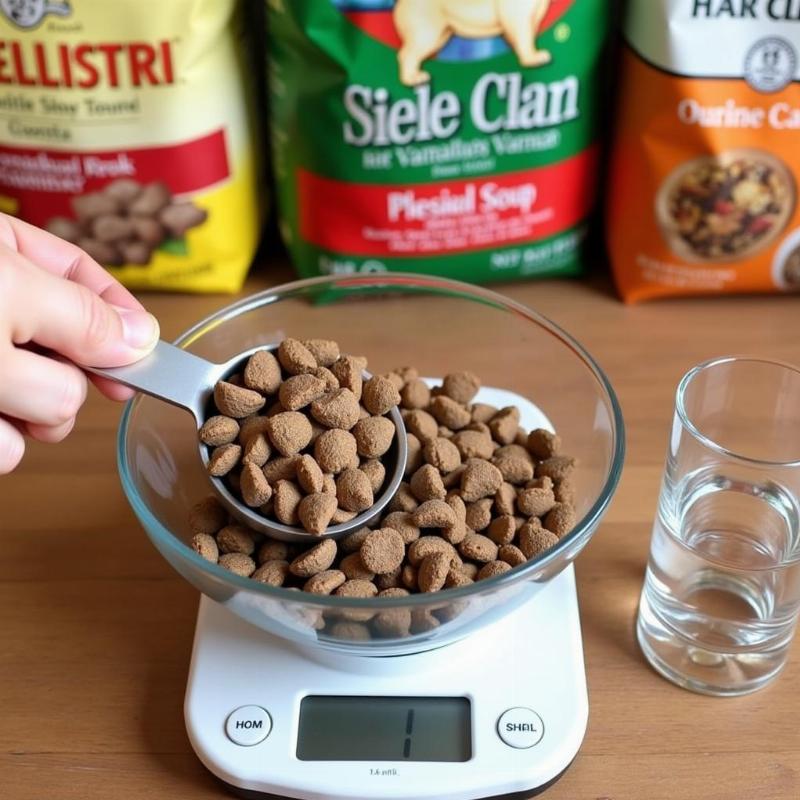Understanding portion control is crucial for your dog’s health and well-being. Knowing how many ounces are in a cup of dog food can help prevent overfeeding or underfeeding, both of which can lead to serious health issues. While a “cup” is a common household measurement, it’s important to realize its inaccuracy when it comes to dog food. The density and kibble size of different dog foods can vary significantly, meaning a cup of one brand could weigh considerably more or less than a cup of another. So, how do you ensure accurate feeding for your furry friend?
Getting the right amount of food for your dog is about more than just filling a cup. It involves understanding the weight of the food, not just the volume. A standard measuring cup holds 8 fluid ounces of water, but that doesn’t directly translate to 8 ounces of dog food by weight. Dry kibble, due to its irregular shape and air pockets, can vary drastically. A cup of small kibble will weigh more than a cup of large kibble, even if they occupy the same volume. Therefore, relying on a measuring cup alone can lead to inaccurate portioning.
Decoding Dog Food Measurements: Ounces vs. Cups
Why is knowing “how many oz in a cup of dog food” so crucial? It boils down to accurate feeding. Overfeeding contributes to obesity, joint problems, and other health issues, while underfeeding can lead to malnutrition and weakened immunity. Using a kitchen scale is the most accurate way to measure your dog’s food. This ensures you’re giving the precise amount recommended by your veterinarian or the dog food manufacturer.
 Understanding dog food measurement
Understanding dog food measurement
Weighing in on the Right Portion: Using a Kitchen Scale
Using a kitchen scale eliminates the guesswork involved in using a measuring cup. Simply place your dog’s bowl on the scale, tare it to zero, and then add the recommended weight of food. This method guarantees your dog receives the correct portion, regardless of kibble size or density.
Kibble Size Matters: Why Volume Can Be Misleading
Think of it this way: a cup of marshmallows will weigh significantly less than a cup of marbles, even though they both fill the cup. The same principle applies to dog food. Different kibble sizes create different air pockets, impacting the weight of a “cup.” Using weight, rather than volume, ensures consistency and accuracy in feeding.
Tips for Accurate Dog Food Measurement
- Invest in a Kitchen Scale: A small digital kitchen scale is an invaluable tool for pet owners.
- Check the Dog Food Bag: Most dog food manufacturers provide feeding guidelines based on your dog’s weight and age, expressed in ounces or grams.
- Consult Your Veterinarian: Your veterinarian can provide tailored feeding recommendations based on your dog’s specific needs and health conditions.
From Cups to Calories: Understanding Your Dog’s Nutritional Needs
“How many oz in a cup of dog food” is just the starting point. The real question is: How many calories does my dog need? This depends on factors such as breed, age, activity level, and overall health. Working with your veterinarian to determine your dog’s ideal caloric intake is vital for maintaining a healthy weight and preventing health problems.
Conclusion: Ditch the Cup, Grab the Scale!
While “how many oz in a cup of dog food” is a common question, the answer is variable and unreliable. For accurate portioning and optimal canine health, ditch the measuring cup and embrace the kitchen scale. This simple switch ensures your furry friend receives the correct amount of food, promoting their overall well-being.
FAQ
- How do I determine the right amount of food for my dog? Consult your veterinarian or check the feeding guidelines on your dog food bag.
- Why is it important to measure dog food accurately? Overfeeding or underfeeding can lead to various health issues.
- What’s the best way to measure dog food? Using a kitchen scale is the most accurate method.
- Why is using a measuring cup unreliable for dog food? Kibble size and density vary, affecting the weight of a “cup.”
- What other factors influence my dog’s nutritional needs? Breed, age, activity level, and overall health play a role.
- Where can I find more information about dog nutrition? Consult your veterinarian or reputable online resources.
- What if my dog has specific dietary needs? Your veterinarian can provide tailored feeding recommendations.
Beautdogs.us is your premier source for all things dog-related in the US. We offer expert advice on dog breeds, care, and product recommendations. Whether you’re a new dog owner or a seasoned pro, Beautdogs.us provides trusted information to help you navigate the world of dog ownership. Contact us today to learn more! Email: [email protected], Phone: +1 501-555-7529. Visit Beautdogs.us for comprehensive dog care information.